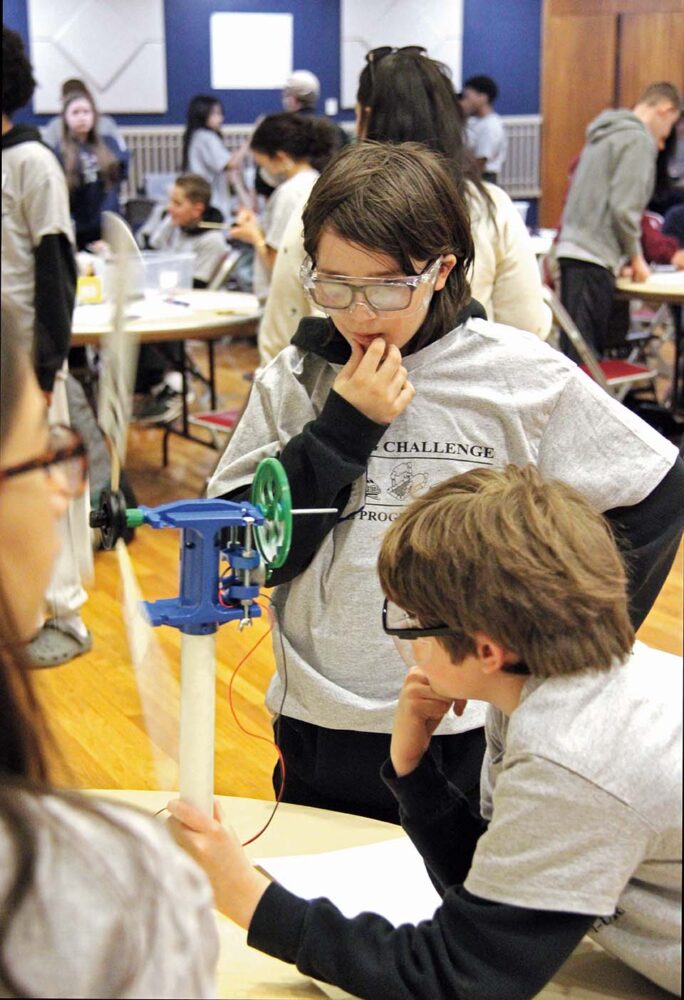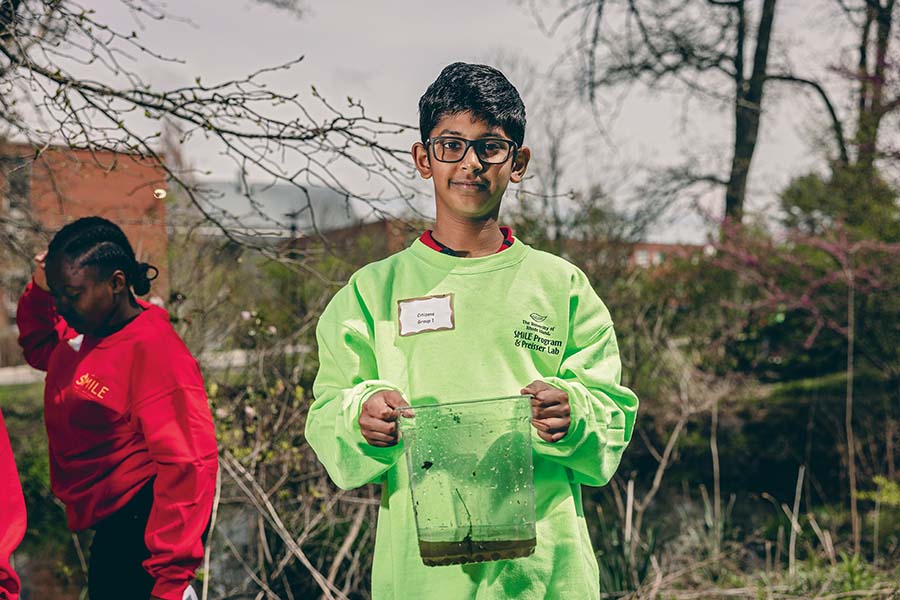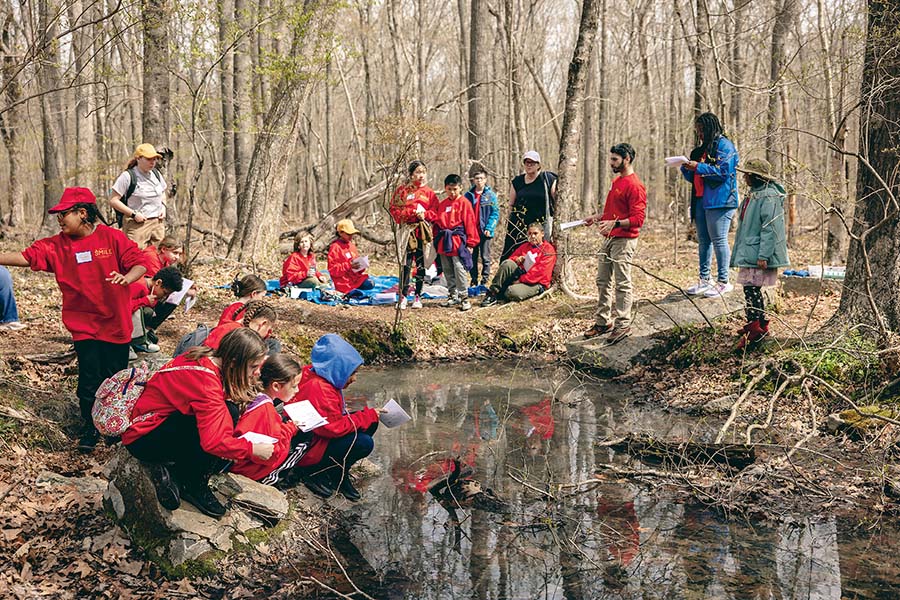Seeing Yourself in Science
After-school STEM programs offer students skills, role models, and community
By Ellen Liberman | Photographs by Jesse BurkeThe team started with no name; some of its members had never met. But once they wrapped their minds around the problem, they came together with a solution.
“Come on, come on!” Layla Savard, a seventh grader from Westerly Middle School, peers through her safety goggles, protractor in hand, as the members of newly constituted Team Gale Force cluster around. Prototype Two of their wind turbine is spinning lazily in the breeze created by a box fan; the voltmeter reading climbed slowly, like a cyclist laboring uphill.
“Let’s check the angle of the blade. We need more tape!” Savard says.
“I got it, I got it!” Hawa Suah, a sixth grader from West Warwick, dashes back to the table littered with scraps of cardboard, gears, and dowels.
On a Friday afternoon in late March, 90 students from six districts around the state converged on the University of Rhode Island campus to meet the SMILE Middle School Engineering Challenge: design and build the fastest wind turbine they could out of a pvc pipe affixed to a wooden base. During the eight-hour day, they would experiment with every aspect of its construction—the number of blades and their length, width, shape, and angle—as they built, re-built, and tested their hypotheses with light guidance from adult mentors milling around the tables.

SMILE program participants compete to build the fastest wind turbine in a hands-on engineering challenge. Photograph by Nicholas Pierson.
SMILE—Science & Math Investigative Learning Experiences—was created by Oregon State University as an after-school club to engage rural students in hands-on science, technology, engineering, and math (STEM) activities.
The goal was to nurture a passion for the sciences among under-represented groups in grades 4-12—minority, low-income, and those who might be the first in their families to attend college—and to prepare them for majors and careers in those fields.
Twenty-nine years ago, then-South Kingstown middle school science teacher Carol Englander established the program here, with funding from West Kingston-based American Power Conversion.
In nearly three decades, SMILE has picked up more sponsors—the Rhode Island Foundation and the University of Rhode Island—and more schools in Westerly, Woonsocket, West Warwick, Central Falls, and Newport.
“We started small, and by the fourth year had kids going to college, some majoring in pharmacy and nursing,” says Englander. “Now we’re up to 23 schools, with about 65% female, at least 55% are [members of minority groups], and 65% get free or reduced lunch.”
SMILE is one of a handful of organizations and programs throughout the state looking to channel the natural curiosity and creativity of children toward a lifelong relationship with science and technology. They share the basic model of providing K-12 students with after-school hands-on activities, but each group approaches the goal from a different vantage point—environmental advocacy, land stewardship, the reclamation of historical roots in the natural world, and the creation of the next generation of scientists, inventors, and artisans.
For example, PVD Young Makers, created in 2018 by then-Mayor Jorge Elorza, offers free workshops at local libraries to provide Providence children with access to advanced digital tools and programs to learn coding, design, and fabrication
Westerly’s Ayers Foundation runs farm-to-school programs, where children can learn agronomy and sustainability in food production on a working farm. Many of these programs are partnerships with like-minded organizations—schools, libraries, museums, nonprofits, and the federal government. The latter has sponsored STEM education since 1862, when the Morrill Act established land grant universities to develop agricultural science; in the post-World War II era, it significantly increased its funding for science and technology research. Policymakers began to lean into STEM education at the lower grades around the turn of the 21st century, and in the last decade, the mission to shore up STEM in elementary and secondary schools has become more urgent.
“The latest report that came out in 2022 shows that STEM education is woefully inadequate. If you look at how [U.S.] students perform on standardized tests that are given around the world, we are below the middle of the pack, which is appalling,” says Julia Phillips, a physicist and member of the National Science Foundation’s National Science Board. “There is a wide and growing disparity in how students perform who come from higher socioeconomic backgrounds, relative to those who come from low socioeconomic status. That gap is large, and it grew with COVID.”
If science is to improve lives, “you need reasonable representation of the society.”
STEM is a large and growing driver of the U.S. economy—nearly a quarter of today’s workers are employed in STEM occupations.
The fear is that without a concerted effort in the earliest school years to encourage all students—particularly girls, people of color, and those from disadvantaged backgrounds—to explore the vast realm of science, the future workforce will not meet the demand.
In 2023, a National Science Foundation report noted that while the U.S. STEM workforce gradually diversified between 2011 and 2021, women and members of minority groups were not represented in STEM occupations or at the highest educational levels relative to their percentage of the population.
This is a problem for economic, scientific, and social reasons, says Phillips.
“More and more jobs require reasonable competence in some form of stem, but we are not producing enough STEM workers … to fill positions. Yet, different experiences, different points of view, and different backgrounds of all sorts enrich the scientific process and enable the consideration of possibilities that no one individual is going to come up with.”
And, she adds, if science is to improve lives, “you need reasonable representation of the society you are trying to have an impact on.”
The koi pond that adorns Westerly Middle School’s front garden is a sad, watery reflection of its former self. The pump that cycled the water up to the rock waterfall stopped working when the underground wires powering a nearby outlet deteriorated beyond repair. Bits of trash rest among the browning reeds, and the koi have long departed. But life will assert itself at any opportunity. Translucent blobs of frog eggs float on the stagnant water, and wild lavender hairs of creeping phlox bloom amid the rocks.
The after-school garden club created a plan to restore this landscape with a solar-powered pump, which they would build themselves. They began on a cool late April afternoon by experimenting with solar panels the size of business cards. They hooked them up with wires and a battery to a tiny fan and observed the speed of the blades when exposed to full sunshine or shade. Tina Scofield, proprietor of Science At Home, led the lesson.
“Look, you can reverse the polarity to the motor and make it spin in the other direction,” she says.
“Science!” declares Amber Thomas, a fifth grader who joined because “it was something to do outside, and I used to garden with my grandpa.”
Wiring the panel to a small music module elicited a digital rendition of “You are My Sunshine,” and fifth grader Emma Cameron immediately got the joke: “Yeah, if you take away its sunshine, it won’t work!”
The other half of the club huddled over a plastic tub to mix a growing medium for the seedling trays. Max and Uli Hence, owners and founders of the Ayers Foundation and its agricultural laboratory, Hillandale Farm, had the kids holding and smelling fistfuls of compost, sand, and soil to understand their weight, density, and value as drainage or water retention. By the club’s conclusion in June, the club’s team of educators expected the water to be tinkling into the fully stocked koi pond, the vegetable beds to be packed with produce, and another crop of enthusiastic young horticulturalists to be successfully raised.
This extra-curricular activity is an outpost of STEM Mentoring RI, a Mystic Aquarium program that began in 2017 at Cranston’s Gladstone Elementary, to pair lower grade students with high-school or adult mentors for after-school science projects.

By 2022, STEM Mentoring RI was statewide, serving 575 kids, with an emphasis on reaching underserved students and communities of color in after-school and summer camps that engage kids in a wide array of environmental, ecological, and engineering activities. Mystic Aquarium develops the curriculum, sometimes in conjunction with other subject experts. For example, the new Ocean Explorations module was created with the National Oceanic and Atmospheric Administration.
Sponsored by The Rhode Island Foundation, STEM Mentoring RI is popular for one reason: kids want it. Statewide Coordinator Caitlyn Blankenship says that surveys consistently show “STEM is the number one request”—especially among third graders through middle school students, who prefer it over sports and arts and crafts.
Fifteen years ago, the Mystic Aquarium began operating informal science education programs after winning a competitive U.S. Department of Justice grant to develop a STEM mentoring program. Now offered at more than 160 sites nationwide, it not only educates students, but also provides professional development and support to teachers.
“Our formal and informal educators can be a little nervous about teaching science, math, engineering, and technology, and we understand that,” says Ayana Melvan, the aquarium’s senior director of strategic partnerships for mission programs. “We do a ton of technical implementation plans to understand what support the educator needs—from a teen informal educator all the way up to a seasoned formal educator—and make them feel very comfortable.”
The burgeoning demand for STEM programming is, in part, a reflection of trends in public education. While neither the federal government nor most states collect teacher vacancy data, in August 2022, Brown University’s Annenberg Institute conservatively estimated that nationwide there were 36,000 vacant positions and at least 163,000 positions being held by underqualified teachers.
The shortages are not evenly distributed by region, subject matter, or grade, but, anecdotally, the shortage of high-quality STEM teachers is particularly acute.
“It’s been a challenge for many years, and it’s really been impacted in the last few years by the pandemic,” says Elizabeth Mulkerrin, president of the National Science Teachers’ Association (NSTA).
In addition, classroom teachers are expected to fulfill so many curricular and administrative requirements, there is little time in the school day at the lower grades for science education. The NSTA has been developing resources to help teachers incorporate STEM concepts and investigations across subject areas such as reading and writing.

And, says Mulkerrin, who is also the Omaha Zoo and Aquarium’s vice president of education, “You are seeing [a] trend of out-of-school programs. We are stepping in because the classroom teachers don’t have the time or the tools to integrate [STEM] cross-curricular.”
Twenty-one bouncing third graders from Newport’s Pell Elementary School, clad in blue and yellow life jackets, board Elizabeth Morris. Early April is the last chance to get a good look at the harbor seals that winter in Narragansett Bay before their northward migration to cooler waters, and this morning’s conditions are promising: abundant sunshine, temperate air, and flat water.
Save The Bay’s Capt. Aaron Saramak pilots the 46-foot vessel about a mile out to the Pell Bridge, while Capt. Eric Pfirrmann tests the students’ knowledge of harbor seals. Teacher Kate O’Neill’s class crowds the portside rail as the mammals come into view, aiming their binoculars to the west.
“Oh my gosh, I see them!”
“They’re so cute!”
After two days of high winds and driving rains, the exhausted seals are draped in a mottled mosaic of greys and browns on an outcropping just off Rose Island. Safe from predators, the seals present themselves to the sun, and to the children, who count about 50 wedged together. The presence of so many harbor seals is an environmental comeback story and policy victory that Pfirrmann boils down for third graders:
“We passed a law. And now, these animals are not just surviving, they’re thriving. Isn’t that cool?”
Save The Bay is Rhode Island’s largest informal science educator. Between their summer camps, in- and after-school programs, aquarium, seal-watch excursions, and beach clean-ups, the nonprofit reaches up to 15,000 students annually with the aim of creating an army of protectors for Rhode Island’s most iconic and important body of water.
“Often, young people have never experienced Narragansett Bay,” says Executive Director Jonathan Stone. “We give them a whole new vocabulary on ecology and a whole new perspective on the bay itself. And when we introduce them to the bay, it’s a life-changing experience.”
The question of impact has not been formally studied, but STEM enrichment programs with longevity have plenty of stories and examples of youngsters who, turned on by their early STEM experiences, have become scientists, science educators, or organization volunteers.
My guidance counselor laughed at me and said that I would never be a marine biologist.
Aura Hernandez’s science career took shape on Rhode Island’s beaches and at her grandparents’ farm in Mexico, where she had free rein to explore the natural world. High school afforded her her first real access to science education, a role model, and a direction.
“My AP biology and physiology teacher, Dr. [David] Upegui was my only Latino teacher, and I was inspired by him to think maybe I can be a woman in science, because being a Mexican woman, this isn’t represented on TV, so I didn’t know I could do it,” she says.
Save The Bay introduced her to environmental management with after-school courses on water quality monitoring at Lonsdale Marsh. A first-generation college student, she graduated from Roger Williams University with a degree in environmental science in 2009 and now runs a program in Central Falls as a Save The Bay science educator.
“Taking that environmental course—that was the light bulb for me that I really wanted to do it for a career. I was once that kid on the other side of learning and exploring and figuring things out. Me being a Latina in marine sciences, I love that I am breaking barriers.”
SMILE graduates Zachary Pimentel and Njoki Gitahi credit SMILE with giving them a template for intellectual investigation and analysis that has served them throughout their adult lives.
After graduating Amherst College in 2004, Gitahi, 40, started working as a geologist, curating the rock collection of New York City’s Museum of Natural History. She now runs her own graphic design firm.
“We explored so many different things in SMILE, and each one gave me a window into different aspects of the sciences, but also different ways of looking at the world,” she says. “I still keep scientific method in mind when doing design—coming up with a hypothesis, testing it, making observations, and figuring out potential solutions. Science is not a monolith, and your relationship to the sciences does not have to be a monolith.”
Pimentel, 29, was the first in his West Warwick family to graduate from high school and went on to earn his Ph.D. in molecular biology at uri. He now works as a senior scientist at the nonprofit Addgene, which helps scientists around the world find and share research materials, and sits on the SMILE board.
“Science is taught like a body of facts that you have to remember,” he says. But SMILE’s hands-on learning showed him its essence and boosted his confidence as he pursued science in high school. “Science is science.The principles you apply in fourth grade are the same principles you apply across the board. The problems just become more complex.”
Melvan, of Mystic Aquarium, recalls her own experience as an African American girl with a burning ambition to become a marine biologist.
“My guidance counselor laughed at me and said that I would never be a marine biologist.”
And that is exactly why Woonsocket High School science teacher Ethel Locke has stuck with SMILE for 19 years.
“One of the things about urban core kids is that people are satisfied with them being a hairdresser or a store manager—and there’s nothing wrong with that. But it is wrong to not hold up a vision for kids that would bring them to the next educational level … Why not hold up an engineering job or a science or a research job? I’m always telling my SMILE kids: ‘Someone believed in you enough to pay for this program. They believe you are a person who can make something of yourself and go places. You can do this. You can go to college.’”
SMILE’s Middle School Engineering Challenge ends with each team presenting its results, and the group with the highest voltmeter reading is named the “winner,” but there are no trophies. The day itself—building a working turbine and running experiments on a college campus—is the prize.
Back at the Gale Force team’s headquarters, Savard and Suah say they both joined SMILE for something to do, and it turned out to be better than they expected.
“The first year of SMILE, I joined to see my friends. Then I got into it more, and I actually enjoy it,” Savard says. “I still don’t like science, but I’m good at engineering. You get to build stuff.”
“I do like this club,” says Suah. “I’m making new friends. This was the first time I ever did anything like this.”
Then the conversation turned to the future, and they began to discuss which Ivy League school they planned to attend.
Which one was better, they wanted to know, Brown or Harvard?
Contact Us
Telephone: (401) 874-6805
Email: allard@uri.edu
Contributor Guidelines
Please review submission guidelines to be considered. d

